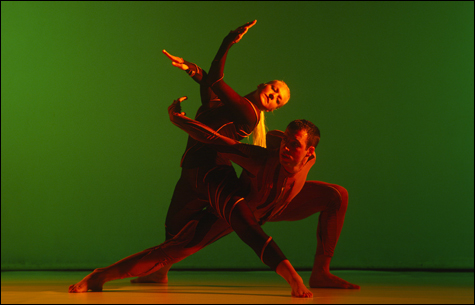
TIGER DANCING: This Henri Oguike work looked more like Meerkat Manor than an aggregation of
stealthy predators.
|
Sometimes we can understand historical truth better when it’s conveyed as theater. At least, that’s the premise of Joanna Haigood’s Invisible Wings, which returned to Jacob’s Pillow last week. We all know the sorry chapter of slavery in America, and the redemptive verses written by the abolitionists who helped slaves escape their masters by passing them through networks of safe houses until they reached free territory. Rather than try to document this vast and tragic story, Invisible Wings evokes its pathos, in vivid, almost archetypal scenes set against a background of musical and narrative folklore.
The idea for the piece — which was commissioned by Jacob’s Pillow and was first presented there in 1998 — came from the discovery that the Carter farm, on which the Pillow is now situated, was a way station along the slaves’ escape route. Several 19th-century buildings belonging to the Carter family are still in use at the Pillow. Haigood’s research apparently didn’t turn up a lot of specifics about the Carter family’s involvement in the banned activities of the underground railroad, so her piece became a series of impressions, dramatizations of slave life in the South and the flight to freedom that often led to a fugitive’s recapture or death. In some ways, the piece derives from the tradition of American pageantry, where a community celebrated local or patriotic events with realistic re-creations and allegorical tableaux, accompanied by music and dancing.
Rather than use the active spaces of Jacob’s Pillow itself, now so heavily imprinted with the buzz of summer-festival life, Haigood laid out Invisible Wings in the outback, away from the present-day amenities familiar to the audience. Starting at dusk, we make our way single file through the woods. Trying not to stumble on the trail, we catch a glimpse of a figure hiding in a tree, a woman huddled under a low bush, a flash of movement that could be a creature or a person.
Then we’re out in the open, on the edge of a field, where black women are hawking their wares at makeshift stalls: vegetables, firewood, brooms made of twigs. They sing spirituals and work songs. A boy jumps up on a stall and does an impromptu jig. A white woman comes out of the crowd and buys a broom. Later, her husband yanks it away from her, after he’s made his way along the row of stalls, demanding his cut from the vendors’ meager receipts.
A horse-drawn wagon comes out of the woods and the crowd follows it through a field, past an old red house, and into another space that’s been cleared in front of a small barn, with boards and hay bales piled up for us to sit on. By now it’s dark, and stage lights subtly blend in to supplement the lanterns and torches used by the performers. The wall of the barn facing us has been cut away, to make a more conventionally theatrical setting. At the back, a big door opens to a field rimmed by deep woods. After unhitching the horse, the farmer’s helper leads it away, and the farmer and his wife take some boards off the wagon. They help a woman up out of a hiding place under the wagon bed and give her a place to sleep on the floor.
She dreams a relentless, increasingly surrealistic panorama of memory and rumor that begins with people emerging from the wagon bed and running every which way into the woods. The sleeping woman (played by Haigood) relives a slave auction when she was separated from her mother. She imagines a carnival contest between the successful black dancer Master Juba and a mocking imitator in blackface, Tom “Jim Crow” Rice. The slave owner seduces his defenseless black servants, and his wife cracks a whip in a terrifying fit of rage. Many of these scenes are enacted on the roof of the barn, in a glare of white light. The characters climb up ladders to get there, and they hang upside down when they’ve been caught.
Throughout all this, there’s singing by Linda Tillery and the Cultural Heritage Choir of San Francisco. Sometimes I found their drawn-out spirituals and upbeat songs set to Afro-rock drumming a distraction from the dramatic spectacle. Sometimes I could only imagine the night whispers of those tense, gloomy woods. Diane Ferlatte tells several meandering stories about mythical heroes and desperate journeys. I think these tales are meant to sew together the dramatized scenes, but, like the music, the narrative material is so extended, it undercuts the strong action of Haigood’s Zaccho Dance Theater.
The story, or the dream, ascends to a spiritual release as the singers and dancers join in a stamping, ecstatic ring shout and Haigood flies calmly through the air over the barn, free at last.